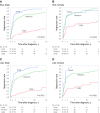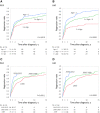Analysis of Coronary Arterial Aneurysm Regression in Patients With Kawasaki Disease by Aneurysm Severity: Factors Associated With Regression
- PMID: 36718857
- PMCID: PMC9973627
- DOI: 10.1161/JAHA.121.022417
Analysis of Coronary Arterial Aneurysm Regression in Patients With Kawasaki Disease by Aneurysm Severity: Factors Associated With Regression
Erratum in
-
Correction to: Analysis of Coronary Arterial Aneurysm Regression in Patients With Kawasaki Disease by Aneurysm Severity: Factors Associated With Regression.J Am Heart Assoc. 2023 Aug;12(15):e027722. doi: 10.1161/JAHA.121.027722. Epub 2023 Jul 25. J Am Heart Assoc. 2023. PMID: 37489747 Free PMC article. No abstract available.
Abstract
Background Coronary arterial aneurysms (CAAs) associated with Kawasaki disease (KD) significantly affect prognosis. However, the clinical course of CAAs and factors associated with CAA regression have not been well analyzed. Methods and Results The cohort of the Z-Score 2nd Project Stage study, a multicenter, retrospective, cohort study involving 44 institutions in Japan including 1006 patients with KD, was examined. CAAs were classified by the z score of their internal diameter in the acute phase: small (z<5), medium (5≤z<10), and large (z≥10). The lower limit of small CAA was based on the Japanese Ministry of Health, Labour and Welfare criteria. In the right coronary artery, the CAA regression rates 10 years after diagnosis were 95.5% for small, 83.2% for medium, and 36.3% for large. In the proximal left anterior descending artery, the regression rates 10 years after diagnosis were 95.3% for small, 80.1% for medium, and 28.8% for large. Cox regression analysis showed that diagnosis under the age of 1 year and onset of KD in 2010 to 2012 for the right coronary artery and the left anterior descending artery, and female for the right coronary artery were significantly associated with a high regression rate, whereas large CAAs for the right coronary artery and the left anterior descending artery were significantly associated with a low regression rate. Conclusions The current study, the largest Japanese study of its kind, found that small aneurysm, recent onset, and diagnosis under the age of 1 year predict regression, and that even giant aneurysms could regress. These data may contribute to long-term management of coronary aneurysms. Registration URL: https://www.umin.ac.jp/ctr/; Unique identifier: UMIN000010606.
Keywords: Kawasaki disease; coronary aneurysm; regression.
Figures




References
-
- Kawasaki T. Acute febrile mucocutaneous syndrome with lymphoid involvement with specific desquamation of the fingers and toes in children. Arerugi. 1967;16:178–222. - PubMed
-
- Research Committee of the Japanese Society of Pediatric Cardiology; Cardiac Surgery Committee for Development of Guidelines for Medical Treatment of Acute Kawasaki Disease . Guidelines for medical treatment of acute Kawasaki disease: report of the Research Committee of the Japanese Society of Pediatric Cardiology and Cardiac Surgery. Pediatr Int. 2012;(56):135–158. - PubMed
Publication types
MeSH terms
Associated data
- Actions
LinkOut - more resources
Full Text Sources
Medical

